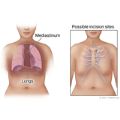Skip to main navigation
Skip to main content
Skip to footer
For
Medicare
For
Providers
For
Brokers
For
Employers
Español
For Individuals & Families:
For Individuals & Families
Medical
Dental
Other Supplemental
Explore coverage through work
How to Buy Health Insurance
Types of Dental Insurance
Open Enrollment vs. Special Enrollment
See all topics
Shop for Medicare plans
Member Guide
Find a Doctor
Log in to myCigna
Home
Knowledge Center
Wellness Library
Mediastinoscopy
Mediastinoscopy
Mediastinoscopy (say "mee-dee-yass-tuh-NAW-skuh-pee") is a procedure that looks at the space behind your breastbone and between your lungs. This area is called the mediastinum (say "mee-dee-ya-STY-num").
During the procedure, a small cut (incision) is made in the neck just above the breastbone or on the left side of the chest next to the breastbone. Then a thin lighted scope (mediastinoscope) is inserted through the incision. The scope lets the doctor look around inside that space. This procedure is done to look for problems such as infection, inflammation, or cancer. A tissue sample (biopsy) can be collected through the scope. The sample can be examined under a microscope for problems.
This procedure usually takes about an hour.
Why It Is Done
Why It Is Done
This procedure is done to:
- Look for problems of the lungs and mediastinum, such as sarcoidosis.
- Diagnose lung cancer or lymphoma (including Hodgkin disease). It is often done to check lymph nodes to see if cancer has spread.
- Diagnose certain types of infection, such as tuberculosis.
How To Prepare
How To Prepare
Procedures can be stressful. This information will help you understand what you can expect. And it will help you safely prepare for your procedure.
Preparing for the procedure
- Your doctor may order certain blood tests, such as a complete blood count or clotting factors, before your procedure.
- Understand exactly what procedure is planned, along with the risks, benefits, and other options. Be sure to ask what may be done, such as lymph nodes being biopsied or removed, for each possible biopsy result.
- Tell your doctor ALL the medicines, vitamins, supplements, and herbal remedies you take. Some may increase the risk of problems during your procedure. Your doctor will tell you if you should stop taking any of them before the procedure and how soon to do it.
- If you take aspirin or some other blood thinner, ask your doctor if you should stop taking it before your procedure. Make sure that you understand exactly what your doctor wants you to do. These medicines increase the risk of bleeding.
- Make sure your doctor and the hospital have a copy of your advance directive. If you don’t have one, you may want to prepare one. It lets others know your health care wishes. It’s a good thing to have before any type of surgery or procedure.
- Be sure you have someone to take you home. Anesthesia and pain medicine will make it unsafe for you to drive or get home on your own.
How It Is Done
How It Is Done
A small cut (incision) is made in the neck just above the breastbone or on the left side of the chest next to the breastbone. Then a thin scope (mediastinoscope) is inserted through the opening. Your doctor will look at the space in your chest between your lungs and heart. Lymph nodes or a tissue sample (biopsy) can be collected through the scope. The sample is then examined under a microscope for problems. These may include infection, inflammation, or cancer.
After the scope is taken out, the incision will be closed with a few stitches and covered with a bandage.
After the procedure, you will be taken to the recovery room. You may feel sleepy for several hours but can usually go home the same day.
How long the test takes
The entire procedure usually takes about an hour.
How It Feels
How It Feels
Before the procedure, you may be given medicine to relax you. You will then get general anesthesia, which will make you sleep.
Risks
Risks
Problems from mediastinoscopy aren't common. But they may include bleeding, infection, a collapsed lung, a tear in the esophagus, damage to a blood vessel, or injury to a nerve near the voice box (larynx) which may cause hoarseness.
Results
Results
Normal
- Lymph nodes are small and smooth, and they appear normal.
- There are no growths, abnormal tissue, or signs of infection.
Abnormal
- Lymph nodes may be enlarged or appear abnormal. This may mean sarcoidosis, infection, or cancer.
- Abnormal growths (such as a tumor) or signs of infection (such as an abscess) may be found in the chest cavity, or mediastinum.
This information does not replace the advice of a doctor. Ignite Healthwise, LLC, disclaims any warranty or liability for your use of this information. Your use of this information means that you agree to the Terms of Use. Learn how we develop our content.
To learn more about Ignite Healthwise, LLC, visit webmdignite.com.
© 2024-2025 Ignite Healthwise, LLC.
Related Links
Medical Tests: Questions to Ask the Doctor
<cipublic-spinner variant="large"><span>Loading…</span></cipublic-spinner>

